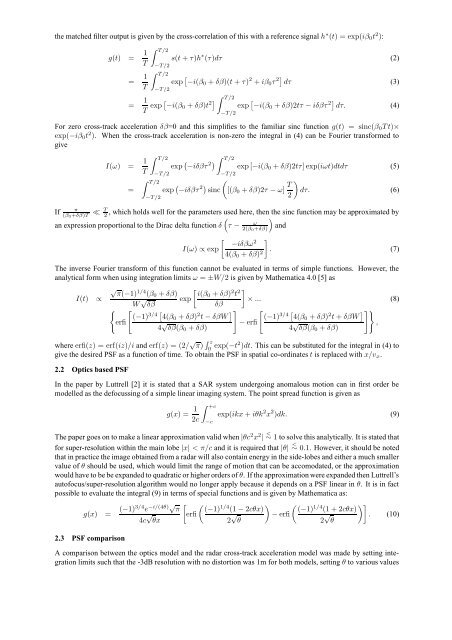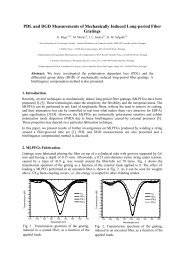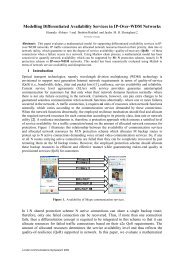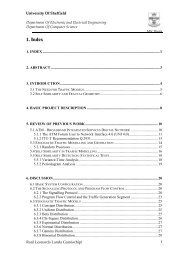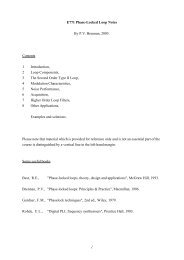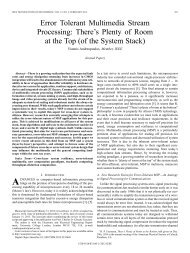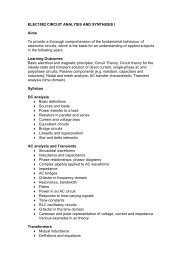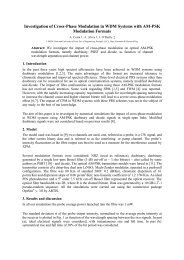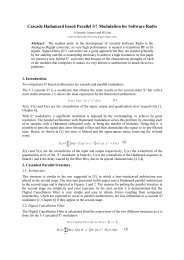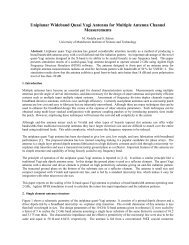Super-resolution and the radar point spread function - UCL ...
Super-resolution and the radar point spread function - UCL ...
Super-resolution and the radar point spread function - UCL ...
Create successful ePaper yourself
Turn your PDF publications into a flip-book with our unique Google optimized e-Paper software.
<strong>the</strong> matched filter output is given by <strong>the</strong> cross-correlation of this with a reference signal h ∗ (t) = exp(iβ 0 t 2 ):g(t) = 1 T= 1 T∫ T/2−T/2∫ T/2−T/2s(t + τ)h ∗ (τ)dτ (2)exp [ −i(β 0 + δβ)(t + τ) 2 + iβ 0 τ 2] dτ (3)= 1 T exp [ −i(β 0 + δβ)t 2] ∫ T/2exp [ −i(β 0 + δβ)2tτ − iδβτ 2] dτ. (4)−T/2For zero cross-track acceleration δβ=0 <strong>and</strong> this simplifies to <strong>the</strong> familiar sinc <strong>function</strong> g(t) = sinc(β 0 T t)×exp(−iβ 0 t 2 ). When <strong>the</strong> cross-track acceleration is non-zero <strong>the</strong> integral in (4) can be Fourier transformed togiveIfπ(β 0+δβ)T ≪ T 2I(ω) = 1 T=∫ T/2−T/2∫ T/2−T/2exp ( −iδβτ 2) ∫ T/2exp [−i(β 0 + δβ)2tτ] exp(iωt)dtdτ (5)exp ( −iδβτ 2) sincan expression proportional to <strong>the</strong> Dirac delta <strong>function</strong> δ−T/2([(β 0 + δβ)2τ − ω] T 2)dτ. (6), which holds well for <strong>the</strong> parameters used here, <strong>the</strong>n <strong>the</strong> sinc <strong>function</strong> may be approximated by()τ − <strong>and</strong>ω2(β 0+δβ)[ ] −iδβω2I(ω) ∝ exp4(β 0 + δβ) 2 . (7)The inverse Fourier transform of this <strong>function</strong> cannot be evaluated in terms of simple <strong>function</strong>s. However, <strong>the</strong>analytical form when using integration limits ω = ±W/2 is given by Ma<strong>the</strong>matica 4.0 [5] as√ π(−1) 1/4 [(β 0 + δβ)I(t) ∝W √ i(β0 + δβ) 2 t 2 ]exp× ... (8)δβδβ{ [ [ (−1)3/44(β 0 + δβ) 2 t − δβW ] ] [ [ (−1)3/44(β 0 + δβ) 2 t + δβW ] ]}erfi4 √ δβ(β 0 + δβ)− erfi4 √ δβ(β 0 + δβ)where erfi(z) = erf(iz)/i <strong>and</strong> erf(z) = (2/ √ π) ∫ z0 exp(−t2 )dt. This can be substituted for <strong>the</strong> integral in (4) togive <strong>the</strong> desired PSF as a <strong>function</strong> of time. To obtain <strong>the</strong> PSF in spatial co-ordinates t is replaced with x/v x .2.2 Optics based PSFIn <strong>the</strong> paper by Luttrell [2] it is stated that a SAR system undergoing anomalous motion can in first order bemodelled as <strong>the</strong> defocussing of a simple linear imaging system. The <strong>point</strong> <strong>spread</strong> <strong>function</strong> is given asg(x) = 1 2c∫ +c−cexp(ikx + iθk 2 x 2 )dk. (9)The paper goes on to make a linear approximation valid when |θc 2 x 2 | ∼ < 1 to solve this analytically. It is stated thatfor super-<strong>resolution</strong> within <strong>the</strong> main lobe |x| < π/c <strong>and</strong> it is required that |θ| ∼ < 0.1. However, it should be notedthat in practice <strong>the</strong> image obtained from a <strong>radar</strong> will also contain energy in <strong>the</strong> side-lobes <strong>and</strong> ei<strong>the</strong>r a much smallervalue of θ should be used, which would limit <strong>the</strong> range of motion that can be accomodated, or <strong>the</strong> approximationwould have to be be exp<strong>and</strong>ed to quadratic or higher orders of θ. If <strong>the</strong> approximation were exp<strong>and</strong>ed <strong>the</strong>n Luttrell’sautofocus/super-<strong>resolution</strong> algorithm would no longer apply because it depends on a PSF linear in θ. It is in factpossible to evaluate <strong>the</strong> integral (9) in terms of special <strong>function</strong>s <strong>and</strong> is given by Ma<strong>the</strong>matica as:g(x) = (−1)3/4 e −i/(4θ)√ π4c √ θx2.3 PSF comparison[erfi( (−1) 1/4 (1 − 2cθx)2 √ θ)− erfi( (−1) 1/4 (1 + 2cθx)2 √ θ,)]. (10)A comparison between <strong>the</strong> optics model <strong>and</strong> <strong>the</strong> <strong>radar</strong> cross-track acceleration model was made by setting integrationlimits such that <strong>the</strong> -3dB <strong>resolution</strong> with no distortion was 1m for both models, setting θ to various values


